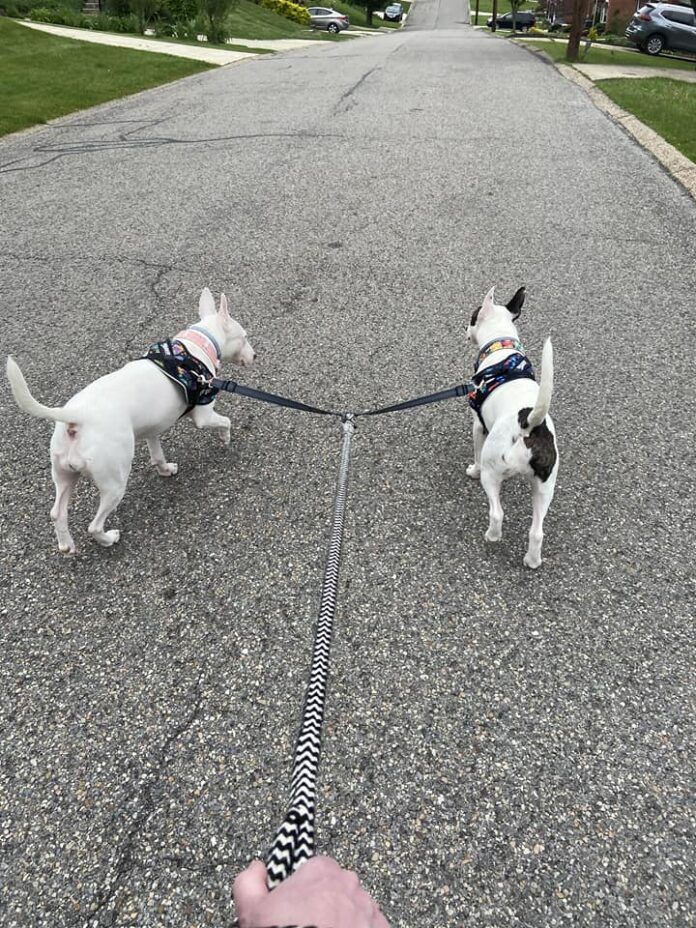I cannot count how many times clients with more than one dog have asked me whether it’s an option to use a leash coupler or double-dog leash. My usual response is probably not, since attaching two dogs together side-by-side successfully requires the right mix of leash skills, compatibility, and temperaments. However, there are situations where it can work.
Why You Shouldn’t Us a Double-Dog Leash
Let’s start with the reasons you should not consider this option:
- One or more of your dogs are reactive on leash. Enough said there. Truly, you do not want to end up in a tangled heap on the pavement from triggers you cannot predict.
- Your dogs have vastly different walking styles. For example, one of your dogs has active goals that include covering as much ground as possible while stopping strategically to sniff certain spots, while the other one really enjoys a slow stroll sniffing all the pee-mail and leaving a response when appropriate. A double leash with two dogs like this will simply create frustration at best and conflict at worst.
- One of your dogs is considerably larger than the other. A two-dog leash in this case can cause unintended physical injury.
- One or both of your dogs has less-than-stellar loose-leash walking skills. Even small dogs can pull so hard that you can face plant. Developing leash skills in advance of trying a coupler is an important first step.
- Your dogs simply tolerate one another rather than having a solid relationship. Using a double-dog leash with this kind of dynamic present can be a recipe for disaster.
- Both your dogs are young enough to enjoy wrestling together frequently. As someone whose giant breed puppy just turned 1 year old, the early days of walking both of my young dogs together were full-on wrestling events at times. Had I been using a leash coupler, it would have been impossible to easily redirect this behavior.
When Can You Use a Double-Dog Leash?
Now, of course, there are scenarios where a double-dog leash is not only a good idea, but it can also make your walk easier since there won’t be any tangled leashes. They do exist! A double-dog leash might work for you if:
- You have two small- to medium-size dogs who have both a good relationship with you as well as with each other, along with having similar walking styles and preferences. Often bonded pairs look to each other for confidence and camaraderie in many contexts and outside the big world, this is usually more evident. The double-dog leashes can add to their emotional safety.
- You have two senior dogs who are more interested in their time with you and sniffing the world than the mileage covered. Of course, they should already be comfortable with one another as well as comfortable on leash. Dogs of a certain age just prefer meandering and pondering smells versus fast tracking.
- You have two well-trained dogs who participate in dog sports that require the ability to be cued into what you need them to do while being attached to equipment that other dogs might view as cumbersome such as sledding. It’s not much of a stretch to train for walking in the neighborhood together cohesively when you have already trained for a complicated sport.
Whether you can successfully try a double dog-leash depends on many factors. The first thing, of course, is that both dogs already know how to walk quietly and politely on a leash. Basically, they both have “leash manners.” Safety for you matters, too, as injuries while walking dogs occur more frequently than you may have guessed.
A double-dog leash is a bad idea if one or both dogs pull on the leash. Please do make sure that you put the right thought into this beforehand for safety’s sake—safety of both you and your two dogs. (Some of these same rules apply to wearing a leash around your waist.)







I have 3 dogs – 2 are similiar in size and 1 significantly smaller. The double leash has been a Godsend when walking all 3! All are respectful of each other and their needs – the double leash has made our walks so much more manageable AND fun!
Years ago, I had an Irish Wolfhound/Poodle and 2 Cairn Terriers. The small dogs were leashed together and then hooked to the big dog. I could drape the big dogs leash over his back and walk hands free while he walked the small dogs. I really miss that boy.
I have a two dog tandem and a three dog for when my parent’s dog is with me. It is actually easier to walk the three together as two dogs will keep the third in line. With two they can pull a bit back and forth but with three, they are working against each other so stay together moving forward a lot easier. I also connect them all in the same order. Diana to the left, Dolly my parent’s dog on the right and Freyja in the middle as her leash skills aren’t quite as good. Walking the three together also help Freyja improve her leash skills as she is excellent at learning from other dogs.
I walked two medium-sized dogs on separate leads until one day, the both went after a rabbit behind me and pulled me down onto the road where I hit my head. So, I coupled them, but the male urinated on the female, who didn’t care. I cared. My solution was to couple them but each was also on its own lead. Each lead felt differently so I could tell them apart without looking. We only stopped when I said so, and at that time, I uncoupled them so the female wouldn’t get urinated on.